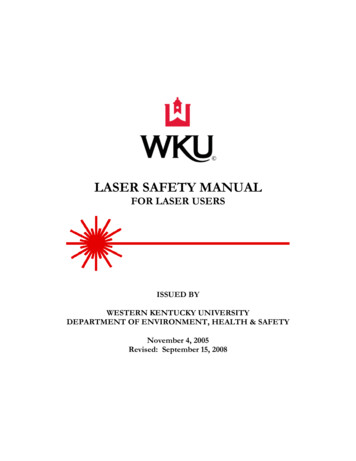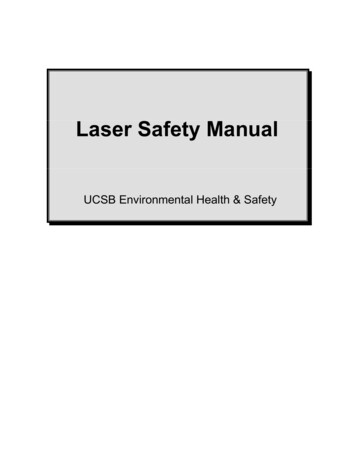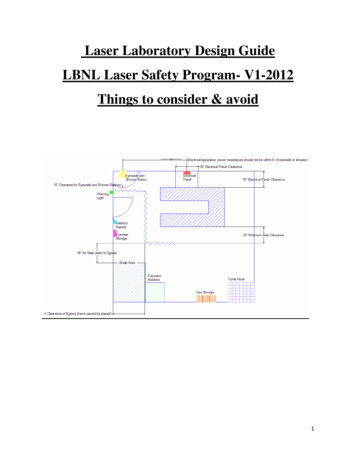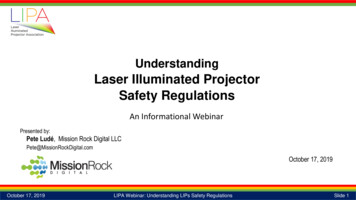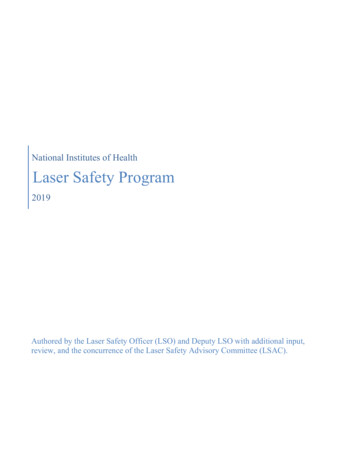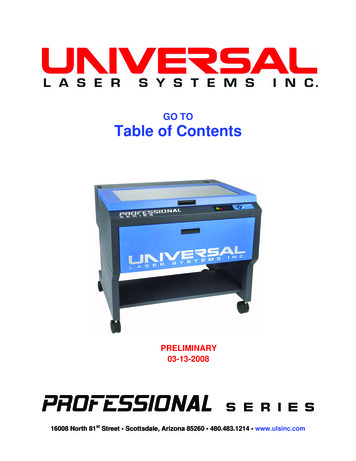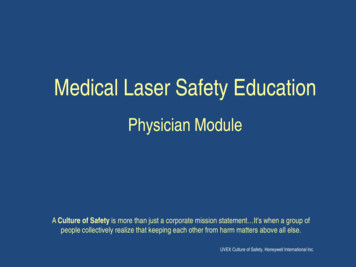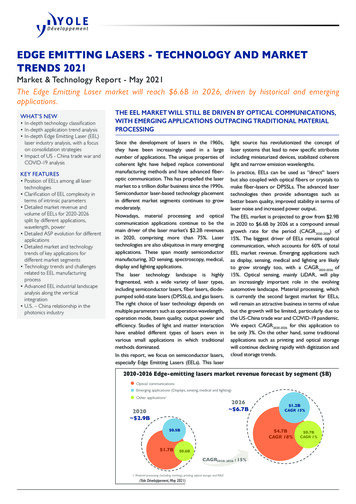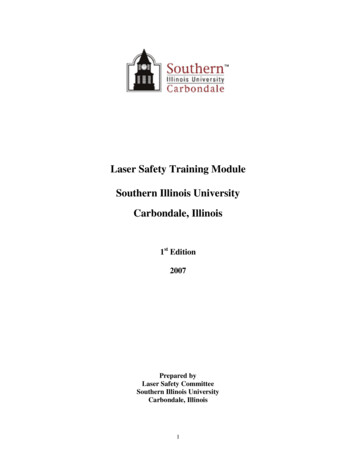
Transcription
Laser Safety Training ModuleSouthern Illinois UniversityCarbondale, Illinois1st Edition2007Prepared byLaser Safety CommitteeSouthern Illinois UniversityCarbondale, Illinois1
TABLE OF CONTENTSLASER SAFETY TRAINING MODULEPAGESection 1SIUSOM Laser Safety ProgramA.IntroductionB.Laser Safety ManualC.Laser Safety Training Requirements1. Annual Refresher Training55556Section 2The Unique Nature of Laser RadiationA.Introduction to LasersB.Characteristics of Lasers1. Intensity2. Coherency3. Monochromaticity4. Collimation6667777Section 3Understanding the LaserA.Basic Operation of the LaserB.Types of Lasing Media1. Solid State2. Gas3. Excimer4. Dye5. SemiconductorC.Mode of Operation1. Continuous Wave2. Pulsed3. Q-Switched8810101011111112121212Section 4ClassificationA.Laser Classification1. Class 12. Class 23. Class 3Class 3aClass 3b4. Class 41313131313141414Section 5Biological Effects of Laser LightA.Eye Injury PotentialB.Skin Injury Potential151516Section 6Laser Beam Hazards and Control MethodsA.General ConsiderationsB.Administrative Controls1. Standard Operating Procedures (SOP)2. Posting and Labeling of Laser Systems17171818182
LASER SAFETY TRAINING MODULEC.Engineering Controls1. Controlling Access to Laser Facilities2. Protective Housings, Interlocks and Shutters3. Key Operation, Power On Indication and Power Meters4. Optical Tables, Beam Alignment and Remote ViewingSystems5. Enclosures, Beam Barriers, Beam Stops and Collimators6. Beam Condensation, Enlargement and Focusing7. Beam Filtration, Nonlinear Optics and Pumping Lasers8. Preventing and Controlling ReflectionsPAGE192020202021222222Section 7Ancillary Hazards and Control Methods in Research LabsA.Toxic Dye HazardsB.Hazards from Laser Generated Air ContaminantsC.Cryogen HazardsD.Compressed Gas HazardsE.High Voltage Power HazardsF.Fire and Explosion HazardsG.Collateral Radiation HazardsH.Noise Hazards222223232324242424Section 8Personal Protective EquipmentA.Laser Protective Eyewear1. Beam AlignmentsB.Skin Protection25252626Section 9Medical Laser Applications and SafetyA.Health Care FacilitiesB.Clinical EnvironmentC.Delivery Systems1. Direct Delivery2. Articulated Arm3. Fiber OpticD.Equipment Safety Procedures1. HCLS Calibration and Alignment2. Laser Hand Piece3. Instrument Draping4. Fibers5. Foot PedalsE.Non-Beam Hazards1. Hazards from Laser Generated Airborne Contaminants2. Local Exhaust Ventilation3. Smoke Evacuator Procedures4. Respiratory Protection5. Blood Borne PathogensF.Fire and Explosion Hazards1. Fire Control2. Endotracheal Tube Fires3. Electrical 1323
G.H.J.K.4. Endoscopic Delivery SystemsPersonal Protective Measures1. Eye Protection2. Skin ProtectionReflection Hazards1. Window Reflective Surface BarriersLaser SignsPatient Safety3232323333333333Section 10Summary35Section 11AppendicesA.Laser Safety Training Certificate and QuizB.Laser Safety GuidelinesC.Laser Safety Checklist for Patient and RoomD.Laser Types and WavelengthsE.Glossary of Laser TermsF.Laser Protective Eyewear for AlignmentsG.Emergencies and Incident Procedures36374344454750514
Section 1 – SIU Laser Safety ProgramA.IntroductionThe purpose of the Southern Illinois University – Carbondale Laser Safety Program is to assurethat all activities related to the ownership, use, or operation of lasers are conducted with theproper precautions and are in compliance with applicable governmental regulations. Theserequirements are based on State and Federal safety standards and guidelines, which include theIllinois Division of Nuclear Safety (IDNS) regulations Part 315, Standards for Protection AgainstLaser Radiation; the American National Standard for the Safe Use of Lasers, ANSI Z136.1–2000and the American National Standard for the Safe Use of Lasers in Health Care Facilities, ANSIZ136.3–1996.This Laser Safety Training Module was developed to provide a basic understanding of laserhazards, laser procedures, and recommendations for the safe use of Class 3b and Class 4 lasersand details health and safety guidelines designed to protect Southern Illinois University (SIU)employees who work with lasers. The requirements and recommended details of this Module areapplicable to all SIU employees who use Class 3b and 4 lasers in clinical and/or researchfacilities.Although Physicians and Principal Investigators (P/PI) bear the ultimate responsibility for thesafe conditions and procedures for laser use in their respective areas, each member of a groupinvolved in laser activities is responsible for reviewing and applying the information put forth inthis Module. Since lasers are used in a variety of applications throughout the SIU campus, thisModule should not be considered a comprehensive review of all potential hazards. If you needadditional information or assistance, contact the Laser Safety Officer (LSO) at 536-2015 orjkane@siumed.edu.B.Laser Safety ManualThe Laser Safety Manual addresses the safety policies, responsibilities, and procedures for thesafe use of lasers at SIU. The P/PI should have a copy of the Laser Safety Manual available foryour reference. This document and other laser related information is also available online fromthe Office of Radiological (ORC) Website at: http://www.siumed.edu/adraf/orc.html.In addition, the P/PI should have available, a Standard Operating Procedures (SOP) document.The SOP is written procedures that specify the safe operation and protection instructions specificto each laser. Each SIU employee should review the contents of the SOP prior to starting workwith a laser or laser system.C.Laser Safety Training RequirementsLaser Safety Training is mandatory for all SIU employees who use or assist in the operation ofClass 3b or 4 lasers. Therefore, individuals are required to review both the Laser Safety Manualand the Laser Safety Training Module. To verify these documents have been read andunderstood, each individual must complete a short quiz, sign a training certificate, and send thequiz and the certificate to the University Laser safety Officer (LSO). The quiz and trainingcertification document can be found in Appendix A. A Certificate of Achievement will be issuedfrom the LSO to each employee who has successfully completed the safety course.5
1.Annual Refresher TrainingEach employee will be required to complete annual refresher training to keep up-to-datewith the latest regulations and University policies. The ORC safety department willassist you in meeting this requirement.Section 2 – The Unique Nature of Laser RadiationA.Introduction to LasersLASER is an acronym, which stands for Light Amplification by Stimulated Emission ofRadiation. Laser light is a form of electromagnetic radiation (Figure 1). Lasers produce light bya process that involves changes in energy states within the atoms of certain materials. Atoms thathave been promoted to higher energy states release this energy in the form of light by a processcalled stimulated emission. The laser light is amplified by reflecting it back and forth in thelasing medium with a pair of mirrors. The laser light is then released in a stream or pulse throughthe partially transmitting mirror at one end of the cavity. The color of laser light is normallyexpressed in terms of the laser's wavelength. The most common unit used in expressing a laser'swavelength is a nanometer (nm). There are one billion nanometers in one meter.Figure 1B.Electromagnetic SpectrumCharacteristics of LasersLaser light emitted from a laser has fundamental characteristics, which distinguishes it from natural light.Laser produced light is extremely intense, coherent, monochromatic and highly collimated. Wavelengthsare typically released in the portion of the electromagnetic spectrum that extends through the ultraviolet,visible, and infrared regions.6
1.IntensityLaser light contains a high concentration of energy per unit area of the beam. Lasers thatemit only a few milliwatts (mW) of power can produce a highly intense beam 1-2millimeters in diameter that will not diverge over a very long distance. Although lasersproduce highly intense light, only a few types of lasers are truly powerful becauseintensity is defined as power per unit area. By comparison, an ordinary light bulb is morepowerful than a typical laser, but the light is not collimated and consequently spreads out.For example, the light irradiance from a 1 mW He-Ne laser can be ONE BILLIONTIMES greater than that from a 100 W incandescent light bulb.2.CoherencyOrdinary light is incoherent or out of phase; light waves start at different times and movein all directions. Laser light, however, is coherent because it is the result of stimulatedemission. All the waves produced by the laser are lined up or in phase with each other(Figure 2). The crests and troughs of each wave line up exactly and reinforce each other.The new light wave starts out exactly in phase with the photon that stimulated it.3.MonochromaticityUnlike ordinary light, which is composed of all the colors of the spectrum, laser light iscomposed of only one color. All the light waves in the beam are composed of the samewavelength. Each laser produces its own characteristic color of light. Some lasers aretunable and can be adjusted to produce several different colors, but they can emit onlyone color at a time. Laser light is approximately 10 million times more monochromaticthan conventional light sources.4.CollimationBecause laser light is coherent it is highly collimated or directional. Laser beams arenarrow, travel in virtually parallel lines, and will not spread out or diverge as light frommost normal sources. Because of this small divergence the intensity of laser light, unlikeordinary light, is fairly constant over long distances. This property of lasers significantlyincreases the hazard potential of the beam. The beam can be easily focused to a smallpoint by a simple lens, dramatically increasing the energy concentration of the beam.Reflections, however, reduce the collimation of the laser beam and result in beamdivergence. Laser beams are reflected to some extent from all surfaces. If the reflectingsurface is mirror-like, the reflection is termed specular. The reflection is called diffuse ifthe reflecting surface is rough. The spreading is greater when the reflection is from arough or diffuse spreading surface.7
Figure 2Characteristics of laser lightSection 3 – Understanding the LaserA.Basic Operation of the LaserThe basic operating concept of the laser is very simple (Figure 3). Laser light is produced bychanges in the energy levels of electrons. Under normal conditions electrons occupy the lowestenergy state in an atom, known as the ground state. Electrons, however, can move from oneenergy level to another by the absorption or emission of energy.For the laser to work, more electrons must be at an excited state than in a ground state (populationinversion). Energy must be pumped into the system to excite the lasing material and promoteelectrons to higher energy states. Although electrons can absorb energy from a variety of externalsources, two methods are most commonly used. The first occurs when an electron absorbs theenergy from a photon of light. The laser may be optically pumped from sources such as flashlamps. The excess energy causes the electrons to jump to a higher energy level, resulting in anexcited or metastable state. Electrons absorb only those photons that contain the exact amount ofenergy needed to pump it to another energy level. In gas lasers, electrons are pumped to higherenergy states by an electrical discharge. In this method, energy is supplied by collisions withelectrons that have been accelerated to a specific energy. In addition to optical and electricalenergy, some lasers are also pumped by chemical and nuclear energy.Once in a higher energy state the atom can return to the ground state by releasing excess energyas heat or light. The wavelength of light released is approximately equal to the energy differencebetween the excited and ground states. When these electrons descend to their ground state,photons of specific (monochromatic) wavelength are emitted in a process called spontaneousemission. Light emitted from phosphorescent materials is an example of spontaneous emission.These materials are excited to higher energy states by light from the sun or a lamp. Photons arereleased when the electrons drop to a lower energy level. Because the source of energy usuallycontains many wavelengths, the electrons can be excited to several energy levels. The releasedphotons will be out of phase and composed of different wavelengths.8
In 1917, Einstein theorized that a photon released from an excited atom could trigger anotherexcited atom to release an identical photon. These two photons could trigger other atoms torelease photons, resulting in a cascade of photons. All of these photons would be of the samefrequency, energy, direction, and in phase with the original triggering photon. This process istermed stimulated emission. The more atoms that can be brought into an excited state, the greaterthe probability of stimulated emission. A population inversion occurs when the number of atomsin an excited state is greater than in the ground state.The key component in making the laser operate properly is the optical cavity. The purpose of theoptical cavity is to provide optimal amplification and stability for the laser beam. Most of thestimulated photons strike the walls of the optical cavity and are lost. However, those photons thatare released in a direction parallel to the optical cavity can interact with other atoms causingfurther stimulated emissions.By placing mirrors at the end of the optical cavity, photons are reflected back and forth into thelasing medium; dramatically increasing the number of photons. The mirrors must be highlyreflective and all scattering from other surfaces in the cavity must be kept low. In a typical laser,one mirror is flat with a reflectance greater than 99.9%. The other mirror is curved with areflectance of 99% and a transmission of 1%. The beam emerges from the partially transmittingcurved mirror. The lasing action will continue as long as energy is supplied to the lasingmedium.Figure 3Laser Operation9
B.Types of Lasing MediaThe lasing medium is a substance that can be stimulated to an excited state by the addition ofenergy. The substance must be transparent to the light it produces and able to exist in ametastable state. The lasing medium may be a solid (state), gas, dye (suspended in a liquid), orsemiconductor. See Appendix D for a listing of laser types (media) typically in use.1.Solid StateThis type of laser contains a solid lasing medium embedded with atoms of the lasingmaterial. Solid state lasers, because of a higher density of lasing atoms, can producemore power output per unit volume than gas lasers. One method of exciting the atoms inlasers is to illuminate the solid laser material with higher-energy light than the laserproduces. This procedure, called pumping, is achieved with brilliant strobe light fromxenon flash tubes, arc lamps, or metal vapor lamps.The first material used to make a laser was a synthetic ruby crystal. This crystal is madefrom aluminum oxide into which a small amount of chromium oxide has been added asan impurity. The chromium acts as the active material in the laser and a xenon flashtubesurrounds the crystal. One end of the rod-shaped crystal is silvered and the other end ispartially silvered. A burst of light from the flashtube excites the chromium atoms andraises them to an excited state, creating a population inversion. Some of the excitedatoms release the excess energy in the form of light photons and return to the groundstate. The photons travel between the reflecting ends of the rod and trigger other excitedatoms through stimulated emission to release photons, which results in an avalanche ofphotons. This stream of photons is discharged through the partially mirrored end in apulse of coherent light. The entire sequence takes only a few milliseconds.Another example of a solid state laser is the Neodymium: YAG (yttrium aluminumgarnet) laser. The neodymium is added as an impurity to the YAG crystal. The YAGlaser is the most common type of crystal laser in use today. Like the ruby crystal, theYAG laser is pumped by a flash lamp and can emit continuous beams or pulses.Continuous power outputs range from a few milliwatts to greater than 100 watts. Pulsedenergies can result in power levels of 5,000 megawatts per pulse.2.GasThe lasing medium of a gas laser can be a pure gas, or a mixture of gases. Gas lasersproduce highly coherent light when an electric current is passed through the medium.The most common type of gaseous laser is the helium-neon. This laser is commonly usedat construction sites, in teaching laboratories, and supermarkets. The helium-neon laseris constructed of a long tube filled with helium and neon under low pressure. A fewmilliamps of direct current applied at several kilovolts is used to excite the helium atoms.The helium atoms in turn excite the neon atoms to a higher energy state by means ofelectron collisions and create a population inversion. Neon atoms fall to the ground stateand release excess energy in the form of a light photon. Photons travels back and forthbetween the reflecting end mirrors and stimulate other neon atoms to release lightphotons. This results in a continuous stream of laser light known as a continuous wave.A bright beam of visible red light emerges from the exit mirror. The helium-neon lasercan emit light continuously for thousands of hours. However, they are extremelyinefficient, converting only 0.1% of the input energy to the laser beam.10
Other examples of gaseous lasers include argon, krypton, and carbon dioxide lasers.Argon and krypton both emit a wide range of wavelengths, mostly in the visible region.The two gases can be mixed to generate most of the visible spectrum. Argon lasers arecommonly used both in industry and research and krypton-argon lasers are typically usedin light showsThe most powerful continuous wave laser is the carbon dioxide laser. It can continuouslyemit powers from less than a watt to hundreds of kilowatts. Carbon dioxide lasers canalso produce extremely short pulses of even higher powers. The laser is pumped by anelectrical discharge and emits invisible far-infrared light.Carbon dioxide lasers operate slightly differently from other lasers. Instead of raisingelectrons to higher energy levels, the energy used to excite carbon dioxide atoms causesthe atoms to vibrate at a different energy level. The carbon dioxide laser is widely usedin the medical field and in industry to drill, cut, and weld materials because of its highpower, high efficiency (up to 30%) and its ease of removing excess heat.3.ExcimerThe excimer laser is another example of a gaseous laser. An excimer is a molecule thatcan exist only in an electronically excited state. The excimer state does not exist innature and exists for only a few nanoseconds in the laboratory. Electrons deposit energyin the laser gas causing an inert gas (argon, krypton, or xenon) to react with a halogen(chlorine, bromine, fluorine, or iodine) to form an excimer. The excimer then breaks upinto its constituent atoms and releases the excess energy as light. These lasers areimportant because they can produce powerful pulses in the ultraviolet region. Excimerlasers are used both in the medical field and in industry applications.4.Dye LasersMany liquid organic dyes will lase if pumped with ultraviolet light. The dyes aredissolved in a liquid such as alcohol to form a solution. The energy levels of the dyes arespaced so close together that they form a continuum. This allows the dye molecules torelease a wide range of wavelengths, mostly in the visible spectrum. The most importantcharacteristic of a dye laser is its tunability. A single wavelength in the dye's range canbe selected or several dyes can be mixed to create a laser that can be tuned across theentire visible range. Dye lasers can also produce extremely short pulses of light.5.Semiconductor LasersLasing action can, under certain circumstances, be initiated by passing an electric currentthrough a semiconductor. Semiconductor lasers, also known as diode lasers, arecharacterized by their small size, small power, high efficiency, and long life. A diodelaser operates predominantly through stimulated emissions. These devices are composedof tiny semiconductor crystals in which the end facets have been cut to reflect light. Thediode laser is pumped by a high intensity electric current and a very small amount of lightof a desired frequency is produced which stimulates an excited electron to fall to a lowerenergy state, giving off laser light. Unlike other lasers, beam divergence is high, andoutput power is measured in microwatts. Semiconductor lasers are made chiefly fromgallium arsenide or gallium aluminum arsenide. These lasers are used in laser printers,video disks, audio disks, and fiber optics communication systems.11
C.Mode of OperationLasers can operate in one of the following three modes:1.Continuous Wave (CW)Continuous wave lasers produce a steady stream of photons. Energy is pumped into thesystem at a rate that equals the light output. Beam characteristics are easily measuredbecause the laser has reached a steady state condition. While most CW lasers use a gasmedium, they can be constructed in a wide variety of lasing materials. An extensivearray of wavelengths may be produced. The He-Ne laser was the first CW laser. Powerlevels can range from a few milliwatts for He-Ne lasers to several kilowatts for carbondioxide lasers.The output power in a continuous wave laser beam is measured in watts. The powerdensity of a beam, also called irradiance or flux, is defined as watts per square centimeter(W/cm2). It is calculated from the output power of the beam and the beam diameter.Power densities can vary from a few watts to hundreds of watts per square centimeter.2.PulsedThese lasers release their energy in highly concentrated pulses of light. The pulse can becreated by chopping a small portion of a continuous wave beam mechanically orelectrically, or by pumping with short intense flashes of light. The energy is concentratedin small bursts delivered in 0.1 to 10 milliseconds per pulse. Pulsed lasers can damagebiological tissues by mechanical blast interactions. Even low energies in the ocular focusregion (0.4 to 1.4 um) can produce retinal damage. Pulsed beams can also be created bychemical means. Terms associated with pulsed beams are choppers, Q-switched, andmode locked. An example of a laser operating in the pulsed mode is the ruby laser.The term used to evaluate a pulsed beam is output energy; measured in joules. The jouleis equal to the power in watts multiplied by the time in seconds. The energy intensity orradiant exposure within a pulsed beam is expressed in joules per square centimeter(J/cm2).3.Q-SwitchingExtremely high power levels can be obtained by using a technique known as "Qswitching" that momentarily stores excess energy. A shutter is placed in the optical pathto prevent laser emission until a very large population inversion has built up. When theshutter is opened the electrons rapidly fall to the ground state releasing a tremendouspulse of energy that lasts only a few nanoseconds. Powers in the megawatt range can beproduced by this technique. Q-switching is commonly used with ruby and neodymiumsolid lasers.12
Section 4 – ClassificationA.Laser ClassificationSince August 1976 Federal law has required manufacturers to properly classify and label lasers.Thus, for most lasers, measurements or calculations to determine the hazard are not necessary. Inaddition, the laser safety standards establishes certain engineering requirements for each class andrequires warning labels that state the maximum output power. Lasers are classified according tothe ability of the primary or reflected beam to injure the eye or skin. The appropriate class isdetermined from the wavelength, power output, and duration of pulse (if pulsed). There are fourlaser classes, with Class 1 representing the least hazardous. All lasers, except Class 1, must belabeled with the appropriate hazard classification.1.Class 1 laserA Class 1 laser is a laser that is incapable of emitting laser radiation in excess of 0.4microwatts (µW). This applies to very low power devices such as those in some semiconductor diode lasers. Class 1 laser devices cannot produce damaging radiation levelsto the eye even if viewed accidentally. Prolonged staring at the laser beam however,should be avoided as a matter of good practice. A completely enclosed laser of a higherclassification is categorized as a Class 1 laser if emissions from the enclosure cannotexceed Class 1 limits. Some of these include laser videodisc players, laser printers, andoptical fiber communication systems. If the enclosure is removed during repair, controlmeasures for the class of laser contained within are required.Lasers that are more powerful than Class I, but have limited emissions due to protectiveenclosures are called embedded lasers. Any removable portion of the protective housingof such lasers have to be secured or interlocked to limit user access to the beam.2.Class 2 – Low Power LasersClass 2 lasers are incapable of causing eye injury within the duration of the blink, oraversion response (0.25 sec). Although these lasers cannot cause eye injury under normalcircumstances, they can produce injury to the retina of the eye if viewed directly for aprolonged period of time. Class 2 lasers are therefore considered to pose a theoreticalhazard but not a realistic hazard in most situations. Class 2 lasers only operate in thevisible range (400 nm to 700 nm) and have power outputs between 0.4 uW and 1 mW forCW lasers. The majority of Class 2 lasers are helium-neon devices.In industrial settings, Class 2 lasers are typically used for alignment or to mark the pathof more powerful invisible lasers. This application is readily used in the medical settingas well.3.Class 3 – Medium Power LasersClass 3 lasers are potentially hazardous upon direct and instantaneous exposure of theeye. The beam if viewed directly, could result in injury within less time than the blinkingreflex. The Class 3 category is divided into two subcategories: 3a and 3b.13
Class 3aClass 3a lasers are similar to the Class 2 devices and cannot damage the eye within theduration of the blink or aversion response. However, injury is possible if the beam isviewed using collecting optics or by staring at the direct beam. Class 3a lasers emitenergy within the visible spectrum but have power outputs between 1.0 and 5.0 mW.They also include some wavelengths in the ultraviolet and infrared regions as long as thepower output is not more than five times the maximum power output of a Class 1 laser.Visible CW HeNe lasers, such as laser pointers, are an example of this class. Class 3alasers must be operated in a location where access to the beam can be controlled with thepotential for viewing of the direct or specularly reflected beam minimized.Class 3bClass 3b lasers include any continuous-wave device with power outputs above 5.0 mWand less than or equal to 500 mW. These lasers can produce accidental injuries to the eyefrom viewing the direct beam or a specularly reflected beam. Except for higher powerClass 3b lasers, this class will not produce a hazardous diffuse reflection unless viewedthrough collecting optics. Additional performance requirements and safety measuresmust be taken to provide protection from the energy emissions of these lasers. Some ofthese precautions include appropriate eye protection for the wavelength being used, beamcontrols (safety interlocks, enclosures, barriers, etc.), and emergency procedures.State regulations require registration of Class 3b lasers. In addition, there must be clearlydefined Standard Operating Procedures (SOP), and documented training of all personnelinvolved in the operation of Class 3b lasers. Contact the LSO for more information onthe proper methods and requirements for using Class 3b lasers.4.Class 4 – High Power LasersClass 4 lasers are the most hazardous lasers. The primary hazards to the skin and eyescome from direct beam exposure, and specular and diffuse energy reflections. Inaddition, Class 4 lasers can ignite flammable targets, create hazardous airbornecontaminants and usually contain a potentially lethal high voltage supply. The poweroutput for CW lasers operating in all wavelength ranges is greater than 500 mW. Allpulsed lasers operating in the ocular focus region (400 nm to 1400 nm) should beconsidered Class 4. Most research, medical, and surgical lasers are categorized as Class4.As with Class 3b lasers, additional performance requirements and safety measures mustbe taken to provide user protection. These requirements are specific to the type andwavelength of laser device being used. Some of these precautions include the creation oflaser-controlled area, reduction of specular hazards, and a clearly defined StandardOperating Procedure (SOP) for the use of the device. Contact the LSO for moreinformation on the requirements for using Class 4 lasers.14
Section 5 – Biological Effects of Laser LightA.Eye Injury PotentialThe most common area for laser beam damage is the eye. The eye is relatively unique because ofits structural fragility. In addition, with some lasers, the eye actively focuses the incident beamonto the retina creating a hazardous concentration of laser energy.The biological effects of laser light on the eye depend predominantly upon wavelength and poweroutput. Laser energy cannot damage a tissue unless it can both reach and be absorbed in thattissue. For this reason, light rays in the visible and near infrared bands of the spectrum will betransmitted through the clea
Laser Signs . 33 . K. Patient Safety . 33 . Section 10 Summary 35 . Section 11 Appendices 36 . A. Laser Safety Training Certificate and Quiz 37 . B. Laser Safety Guidelines 43 . C. Laser Safety Checklist for Patient and Room 44 . D. Laser Types and Wavelengths 45 . E.

